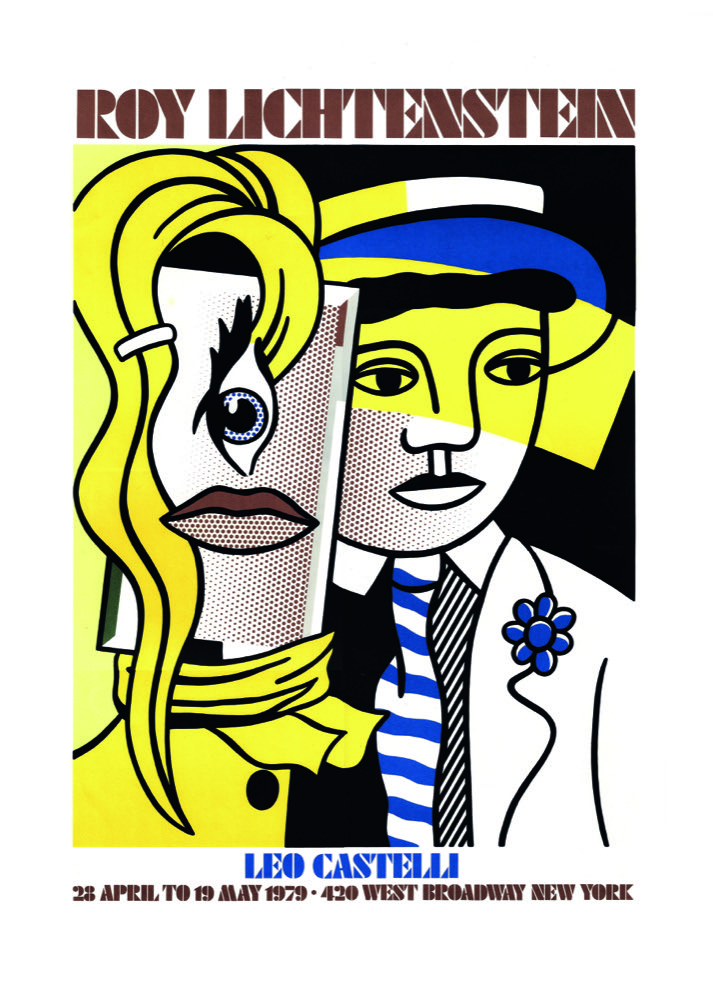LICHTENSTEIN Roy
[Roy Fox Lichtenstein] (New York 1923 - New York 1997)
Roy Lichtenstein [Stepping Out, 1978]
Luogo: New York
Editore: Leo Castelli
Stampatore: senza indicazione dello stampatore
Anno: 1979 [aprile]
Legatura: poster impresso al solo recto
Dimensioni: 91x65 cm
Pagine: N. D.
Descrizione: riproduzione del dipinto dell'artista stampata in serigrafia a colori («Stepping Out», 1978). Pubblicato in occasione della mostra (New York, Leo Castelli, 24 aprile - 19 maggio 1979). Esemplare non ripiegato, in perfette condizioni. Edizione originale.
Bibliografia: Jürgen Döring, - Claus von der Osten, «Lichtenstein Posters», Munich - Berlin - London - New York, Prestel, 2008: pag. 77, cat. n. 33
Prezzo: € 250ORDINA / ORDER
"«Stepping Out» is marked by Lichtenstein's customary restriction to the primary colors and to black and white, by his thick black outlines, and by the absence of any shading except that provided by the dots imitating those used to print comic strips. Yet beneath the simplicity of means and commonplace subject matter lies a sophisticated art founded on a great deal of knowledge and skill. Lichtenstein here depicts a man and woman, side by side, both quite dapperly dressed. The male is based on a figure in Fernand Léger's painting Three Musicians of 1944 (Museum of Modern Art, New York), but seen in mirror image. He wears a straw hat, high-collared shirt, and striped tie; the flower in his lapel is borrowed from another Léger painting. The female figure, with her dramatically reduced and displaced features, resembles the Surrealistic women depicted by Picasso during the 1930s. Her face has been reduced to a single eye set on its side, a mouth, and a long lock of cascading blond hair. The composition of «Stepping Out» is complex and rather elaborate. The figures, while quite different in appearance and style of dress, are united through shape and color: the sweeping curve of the woman's hair is answered by the curve of her companion's lapel; the diagonal yellow of the end of her scarf is echoed in the yellow rectangle that covers the top of his face; the red Benday dots cover half of both faces; and the black that serves as background for the man invades the area behind the woman" (Website: The Met Fifth Avenue Museum, New York).
"«Stepping Out» è caratterizzato dalla consueta predilezione di Lichtenstein per i colori primari e il bianco e nero, dai suoi spessi contorni neri e dall'assenza di qualsiasi sfumatura tranne quella fornita dai punti che imitano quelli usati per stampare i fumetti. Eppure sotto la semplicità dei mezzi e dei soggetti nasconde un'arte sofisticata fondata su una raffinata conoscenza e abilità. Lichtenstein qui raffigura un uomo e una donna, fianco a fianco, entrambi vestiti in modo piuttosto elegante.Il maschio è basato su una figura nel dipinto di Fernand Léger «Three Musicians» del 1944 (Museum of Modern Art, New York), ma visto in un'immagine speculare. Indossa un cappello di paglia, camicia a collo alto e cravatta a righe; il fiore sul bavero è preso in prestito da un altro dipinto di Léger. La figura femminile, con i suoi lineamenti drammaticamente scomposti, ricorda le donne surrealiste ritratte da Picasso negli anni 30. Il suo volto è stato ridotto a un solo occhio posto di lato, una bocca e una lunga ciocca di capelli biondi a cascata. «Stepping Out» è complesso e piuttosto elaborato. Le figure, sebbene piuttosto diverse nell'aspetto e nello stile del vestito, sono unite per forma e colore: all'ampia curva dei capelli della donna risponde la curva del bavero del suo compagno; il giallo diagonale dell'estremità della sua sciarpa fa eco nel rettangolo giallo che gli copre la parte superiore del viso; i puntini rossi "Ben Day" coprono metà di entrambe le facce; e il nero che fa da sfondo all'uomo invade l'area alle spalle della donna" (dalla pagina web del The Met Fifth Avenue Museum, New York).
"«Stepping Out» è caratterizzato dalla consueta predilezione di Lichtenstein per i colori primari e il bianco e nero, dai suoi spessi contorni neri e dall'assenza di qualsiasi sfumatura tranne quella fornita dai punti che imitano quelli usati per stampare i fumetti. Eppure sotto la semplicità dei mezzi e dei soggetti nasconde un'arte sofisticata fondata su una raffinata conoscenza e abilità. Lichtenstein qui raffigura un uomo e una donna, fianco a fianco, entrambi vestiti in modo piuttosto elegante.Il maschio è basato su una figura nel dipinto di Fernand Léger «Three Musicians» del 1944 (Museum of Modern Art, New York), ma visto in un'immagine speculare. Indossa un cappello di paglia, camicia a collo alto e cravatta a righe; il fiore sul bavero è preso in prestito da un altro dipinto di Léger. La figura femminile, con i suoi lineamenti drammaticamente scomposti, ricorda le donne surrealiste ritratte da Picasso negli anni 30. Il suo volto è stato ridotto a un solo occhio posto di lato, una bocca e una lunga ciocca di capelli biondi a cascata. «Stepping Out» è complesso e piuttosto elaborato. Le figure, sebbene piuttosto diverse nell'aspetto e nello stile del vestito, sono unite per forma e colore: all'ampia curva dei capelli della donna risponde la curva del bavero del suo compagno; il giallo diagonale dell'estremità della sua sciarpa fa eco nel rettangolo giallo che gli copre la parte superiore del viso; i puntini rossi "Ben Day" coprono metà di entrambe le facce; e il nero che fa da sfondo all'uomo invade l'area alle spalle della donna" (dalla pagina web del The Met Fifth Avenue Museum, New York).

